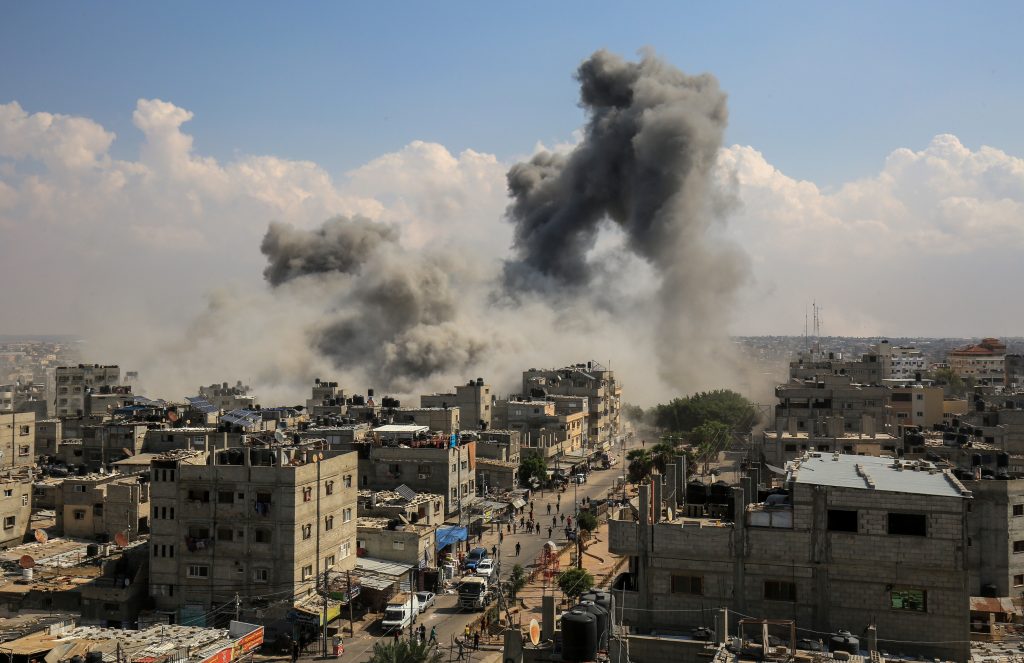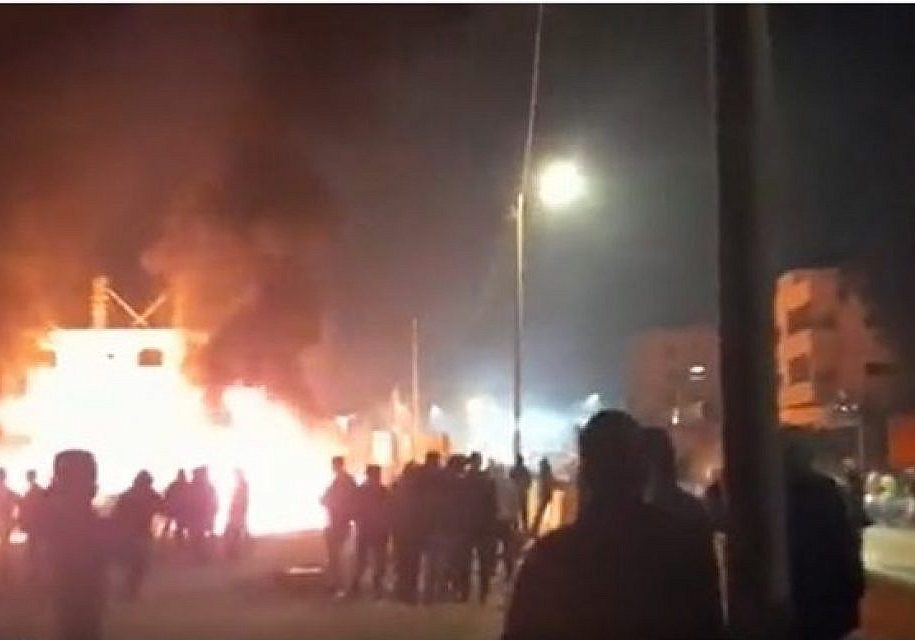FRESH AIR
“Lies, damned lies and statistics” in Gaza
January 17, 2024 | Oved Lobel

Cumulative civilian casualty estimates from wars are, by themselves, neither a moral metric nor a useful analytical tool. Not only are they notoriously unreliable, but they also tell us little to nothing about whether a war is being conducted according to International Humanitarian Law (IHL). This is especially true in Gaza, where all the widely-cited but dubious casualty estimates can ultimately be sourced solely to the terrorist organisation Hamas, which has embedded its military infrastructure among civilians for the specific purpose of maximising civilian deaths.
In any war or large military operation, there are inevitably going to be incidents of genuine legal violations and failures of discipline, as well as ‘fog of war’ accidents and intelligence and operational errors that cause casualties.
To even begin to accurately assess the justifiability or otherwise of casualties during a military operation, one would have to look at every single casualty incident individually, whether air or artillery strike or shooting, and have accurate information about which side caused the deaths; the precise intelligence that went into each strike or engagement; whether a strike was “dynamic” as opposed to “deliberate” – that is, called in by or coordinated with ground forces engaging the enemy rather than against a pre-vetted target – as well as the decision-making processes used by commanders, among a host of other details. Cumulative numbers, even if accurate, do not convey any of the elements of this essential information.
During the Bosnian War (1992-1995), for instance, according to the best data available, of the approximately 100,000 killed or missing, the overwhelming majority, 59%, seem to have been combatants. This number would tell us nothing about how that war was fought or the extent of atrocities, including what was judged to be an act of genocide at Srebrenica.
Similarly, while there are no reliable figures for casualties from the Syrian civil war, all available figures show that the majority of deaths since 2011 were combatants. You would never know about the Syrian regime’s use of chemical weapons and starvation sieges, the massacres of civilians and political prisoners and a plethora of other horrific war crimes from this topline figure.
Even if one were to trust the casualty estimates coming out of Gaza, one would have to know the usual civilian-combatant casualty ratios in wars, particularly in comparable wars. Those criticising Israel’s conduct based solely on purported civilian casualties would need some sort of realistic baseline for what a war in similar circumstances that fully complies with IHL ought to look like in order to make any judgements. If Israel’s war is alleged to be especially brutal or destructive, to what is it being compared to arrive at such an assessment?
The most superficially comparable situation to Israel’s war against Hamas is the US-led war against the Islamic State (IS), particularly the campaigns to retake the cities of Mosul and Raqqa. In fact, these campaigns are not comparable to the war against Hamas in Gaza for a variety of reasons.
Moreover, it’s difficult, if not impossible, to even make statistical comparisons because, as in nearly every conflict throughout history, we actually have no reliable estimates about overall casualties, casualties per munition or anything else for the anti-IS campaigns.
What can be gleaned from Raqqa and Mosul is that urban warfare is hideously destructive and results in extensive collateral damage, even for countries attempting to adhere to IHL. Fighting against Hamas in Gaza was always likely to be even more destructive, quantitatively, for the reasons listed below, but contrary to hysterical claims made by some politicians, analysts and journalists, it is not a qualitatively more destructive war.
War against IS vs war against Hamas
In Iraq, the combination of militias and security forces that liberated Mosul from IS, backed by US and allied airpower and artillery, were fighting to take back their own city, with a population almost entirely hostile to IS. They had around a year to plan the operation, had all the initiative and were under no domestic or international political or time constraints to complete the operation within a given period. Moreover, the Iraqi security forces lost more than 1,200 men in the battle, and perhaps more than 8,000.
Israel, by contrast, had approximately a week to plan an incredibly complex operation, having been caught entirely off-guard by the Hamas invasion on October 7. The IDF is fighting to remove a terrorist regime from territory Israel does not control and where the population is almost entirely hostile to Israel and supportive of Hamas.
In addition, Israel cannot afford an operation that lasts as long as the battle for Mosul did, nor can it afford the number of casualties sustained by Iraqi security forces around Mosul or US partner forces in Raqqa. The reason for this is simple: because of Israel’s conscript and reservist system, its soldiers are drawn from its workforce. On top of that, there is an insurmountable political and social imperative in Israeli society to preserve the lives of soldiers insofar as possible.
Internationally, meanwhile, pressure on Israel to either finish the war as quickly as possible or simply halt it entirely, regardless of the outcome, has been building since even before Israel launched its ground operation.
There are also substantive differences, both tactically and numerically, between Hamas and IS, including the reality that Hamas had 16 years to build up its much more impressive and embedded military infrastructure in civilian areas.
Finally, a key difference between the battlefields, one of many, is that the US and its partners on the ground were able to facilitate the evacuation of civilians from both Raqqa and Mosul before and during the battles, leaving far smaller civilian populations trapped in the cities while also reducing the battlespace by allowing IS operatives to leave the cities. IS eventually melted away and transitioned back into an insurgency.
In Gaza, where Hamas utilises every inch to attack Israel and is unwilling and unable to leave the battlefield like IS did, it is unfortunately impossible for civilians to flee to fully safe areas. They cannot exit into the Sinai both because Egypt will not allow it and because the international community has decided that temporarily displacing Palestinian civilians out of Gaza is worse than keeping them as human shields for Hamas.
Given all these factors, one would expect an Israeli operation necessarily to be more destructive over a shorter timeframe and to result in more civilian casualties. However, this indicates little about the conduct of the war.
The folly of numbers
How many IS fighters held Mosul? How many were killed by coalition strikes and Iraqi forces? How many civilians were in the city at any given time during the operation, and how many were killed and by whom? The answers to all of these questions are entirely unknown, so no useful statistical comparison can be made.
Estimates of IS operatives fighting for the city range from 3,000 or less to around 9,000 to more than 12,000. Importantly, hundreds of IS operatives killed themselves in more than 480 suicide car bombings and other suicide bombings.
The civilian population at the time the battle began was estimated to be 680,000 or less, with hundreds of thousands fleeing thereafter throughout the battle. Civilian casualty estimates due to US-led coalition air and artillery strikes range from 326 to at least 3,200, the latter number including attacks attributed to Iraqi ground forces, with 9,000-11,000 civilians allegedly killed overall. Still another estimate claims more than 5,800 civilians may have been killed by Iraqi and coalition forces in West Mosul alone. An estimate by Kurdish intelligence put the civilian death toll over 40,000.
We are therefore left with no useful figures to judge the campaign and know little beyond the fact that it achieved victory and mostly destroyed the city.
Raqqa presents similar problems, and all that can really be said is that the level of destruction and civilian casualties were judged to be high, despite attempts to mitigate both. Estimates of how many civilians were actually killed by coalition strikes range from 178 to more than 1,600, with 2,400 or more civilian deaths overall.
But how many civilians were in the city at any given point? According to a RAND study:
Raqqa’s civilian population declined steadily during the operation. An NGO estimated that the civilian population in Raqqa declined from an estimated 269,000 in April 2017 to as few as 2,000 to 3,000 civilians by the end of the fighting in October 2017…The NGO estimated that, on June 23, 2017, 100,000–150,000 civilians remained in Raqqa; on July 6, that estimate declined to 20,000–50,000. And the NGO estimated that, on August 18, approximately one week after the halfway point of the operation and roughly at the start of the most-intense bombardment, the civilian population of Raqqa was approximately 22,000 people.
There is also no reliable information on how many IS operatives were killed and how many left or melted away. US partner forces on the ground took more than 650 casualties during the battle, an extremely high toll. As with Mosul, we have no idea what the civilian-to-terrorist casualty ratio is or ought to be.
Once again, the only certainty regarding the battle for Raqqa, given the lack of any reliable numbers on any aspect of the battle, is that the city had to be almost entirely destroyed and most of its population displaced to achieve victory.
Contrast all of this with Hamas, which fights very differently and is estimated to have 30,000 or more fighters in Gaza, with its sister terrorist groups adding thousands or even tens of thousands more. Israel is therefore facing an exponentially larger and more professional and embedded force than the combined numbers of IS terrorists in Mosul and Raqqa.
Additionally, the civilian population of Gaza, concentrated and kettled in a smaller battlespace, is more than double that of Mosul and Raqqa combined during the battles to liberate them from IS, and the majority of the civilians in those cities were able to flee beyond the battle zone. The logic of this arithmetic for Palestinian civilians is grisly – as it would be regardless of the tactics Israel employed – and is reflected in the undeniably high civilian death toll in Gaza.
Tragic but within the normal range
Israel claims to have killed more than 9,000 operatives of Hamas and other terrorist groups thus far in Gaza. If one believes Hamas that approximately 23,000 Palestinians have been killed overall as well as the Israeli estimate of terrorist casualties – neither number can be verified – that means that, at worst, approximately 60%-65% of casualties to date have been civilians. This is tragic, but by no means excessive for conflicts in general.
Frustratingly, these details will not stop anti-Israel activists and officials from building a facile narrative around unreliable casualty numbers and accusing Israel of “genocide”. But for those genuinely interested in how the war against Hamas compares to other, at least superficially similar operations, the figures available strongly suggest that it is neither especially deadly nor especially destructive. As journalist and analyst Jonathan Spyer, one of the few people to cover both the war against IS as well as the war in Gaza on the ground, recently pointed out, “In so far as it can be currently ascertained, the ratio of civilian to military dead in Gaza appears then to broadly resemble that of Mosul.”
In reality, the war against Hamas appears to be a comparatively typical example of devastating urban warfare against an entrenched jihadist enemy, though compressed in time and space due to the factors enumerated above.
RELATED ARTICLES

‘Time’s up for talk’: Joel Burnie discusses Antisemitism Envoy’s report on Sky News

‘Optimism’ for Hamas to ‘exile’ their power and create a permanent ceasefire with Israel: Joel Burnie on Sky News

Australian government’s response to Iran-Israel conflict ‘disappointing’: Paul Rubenstein on Sky News




















